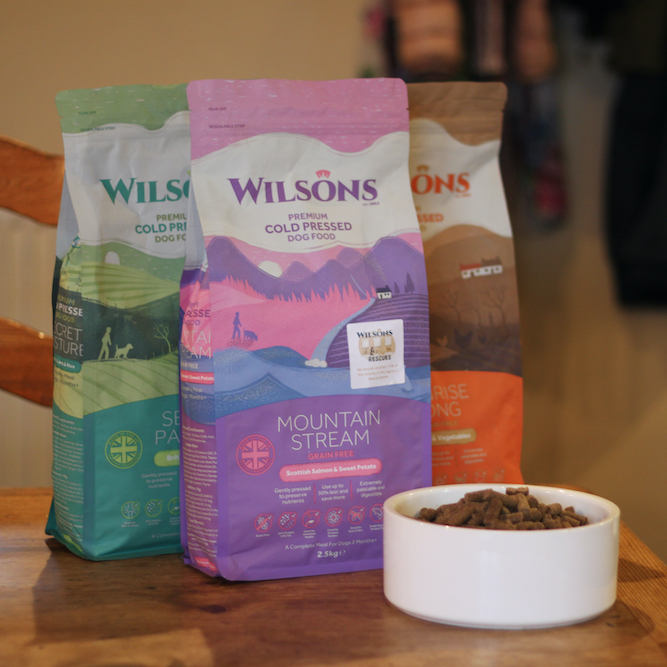
Never before has there been so much choice when it comes to dog food. As a new dog owner or even someone who is thinking about making a change in their dog’s diet, it can be completely overwhelming when faced with the decision of what to choose.
In this article, I will be looking at providing a simple overview, from the perspective of one dog owner to another, of the different choices that are out there and some of the important things to remember when deciding what is right for you and your dog.
What are the options?
The first thing to understand is the difference between the terms ‘complete’ and ‘complementary’.
A complete dog food is classed as a food that contains all the nutrients that are considered essential to keep your dog healthy. In a nutshell, the theory is that you could just feed that one type of food to your dog, and nothing else, and it would not be detrimental to their wellbeing.
Complete dog foods can come in many different forms, from dry to wet and even raw but I’ll go into those in more detail later on.
Complementary dog foods are the opposite and relate to the types of foods you can give to your dog as PART of its diet, but on their own, they are not enough to sustain your dog and keep them healthy. An example of this might be cuts of raw meat to go with mixer biscuits.
What are the different food types?
There are 4 main different food types to think about:
- Dry Food
- Wet Food
- Raw Food
- Fresh Food

Dry Food
This is perhaps the most popular food used in the UK and that’s largely due to its convenience. Dry food is readily available both online and on the high street, it’s super easy to store and there is not much preparation required.

Within the dry food category, it’s important to note that you can get variations and that relates to how the food is produced.
The Extrusion method is probably considered to be the most ‘processed’ method, as it requires all the raw materials to be passed through a massive steam cooker machine and then cut into individual biscuits, dried, cooled and coated in oils to give them a better flavour. Some people argue this method helps kill parasites though!
You can also get baked dry food which is widely thought to be better and retains more of the nutrients as it’s not cooked in high-pressure cookers. The downside is, they generally require wheat gluten to bind the biscuits so can be tricky for dogs who may have allergies.
Cold-pressed foods are newer to the market and are proving to be popular. They have all the benefits from dry food processing but at much lower temperatures!
Air drying as a method for producing dry food takes things to another level. Raw ingredients tend to start out fresh and are exposed to heated air to remove the water. This method is considered much better for retaining all the goodness and nutrients.
Freeze-dried foods are perhaps the most expensive of the dry food varieties and this is because the food is frozen first and then gently heated in a vacuum to remove the moisture. There is very little damage to the nutrients in the food and it has a great shelf life.
Wet Food
When we talk about wet foods, we are referring to those that we see in cans, tins and pouches, that have typically always been available on our supermarket shelves. Ingredients in wet foods are pre-cooked and vacuum-sealed in their containers before being heat sterilized.
Some people argue that the sterilization process is harmful to the nutrients in the food, however, some prefer wet food as the high moisture content is great for dogs who don’t drink much.

Raw Food
Raw feeding has grown in popularity significantly over recent years and that is, for the most part, down to the fact it is considered to be the most natural way to feed our dogs. Some dog owners prepare their own raw food for their dogs but due to the convenience factor, many have taken to buying it from the growing number of providers that now specialize in this food type.

“If your dog has any specific health problems, or if you are in any doubt as to its feeding requirements we recommend you consult your veterinarian for further advice.”
Fresh Food
Fresh food for dogs is a version of home cooking for our four-legged friends. This is a new, popular concept, as it means that all the processing of the ingredients is removed and, in theory, all the goodness and nutritional value is retained. If you go down the fresh foods route, as with the food we cook for ourselves, you have to take into consideration the shelf life of the food once prepared and the fact that it will need to be stored in the fridge or freezer.
As you can see there is a lot of choice out there and that’s before we even start to examine the different brands available in the market. One thing that is for certain, everyone will have their own recommendations and have their own ways of feeding their dogs.
Choose what's right for you
Now we understand the different choices, it’s important to think about what considerations we need to make when choosing the right dog food for our dogs:
- Lifestyle of you and your dog – if you are a super busy pet parent who doesn’t have time to dedicate to preparing food on a regular basis then fresh food probably isn’t the best choice for you.
- Budget – some choices are more expensive than others and whatever you pick needs to be sustainable in the long term.
- Your dog’s individual health conditions – does your dog have allergies or existing health conditions you need to factor in? Your vet will be able to advise if your dog has any specific dietary requirements that may play a part in your decision-making process.
- Your ethical choices – for those who are vegan or vegetarian, choosing a raw diet where you have to handle meat probably won’t be the right choice for you.
- Your dog’s tastes – sometimes the decision boils down to what your dog will eat. Some dogs are fussy eaters so you have to do what works for them.
Be realistic about what works for you, as the last thing you want is to keep chopping and changing your dog’s diet all the time, as this in itself will cause the dog issues.
You need to feed your dog what you feel is right, taking on board all of the advice. Your dog will show if this diet is working. If they look their best and have the energy to perform their natural breed role then this diet works for your dog.
If your dog has any specific health problems or if you are in any doubt as to its feeding requirements, we recommend you consult your veterinarian for further advice.
Food and diet is such a controversial subject amongst dog owners. At K9 Nation we believe in everyone making their own decisions about what is right for them and their dogs, and simply encourage our community members to make informed choices.
Factors to think about with raw feeding include, having to store it in the freezer and remembering to defrost in advance, as well as how practical it is when you go away and have to transport and store the food when not in your own home. Some people use raw food as a complete feeding method and some use it to complement dry foods. There is much debate over the nutritional balance of raw feeding in isolation.
References
https://www.allaboutdogfood.co.uk/
